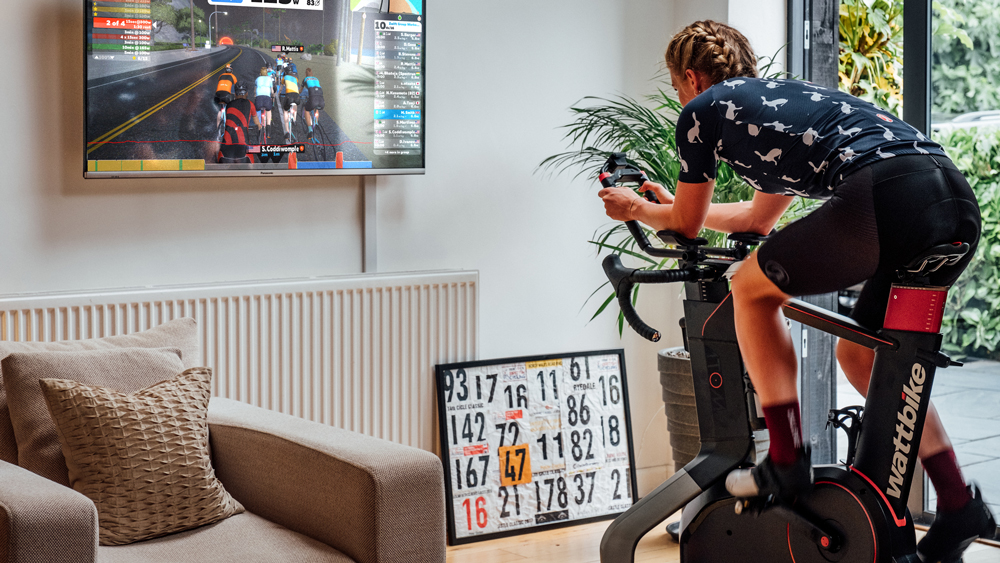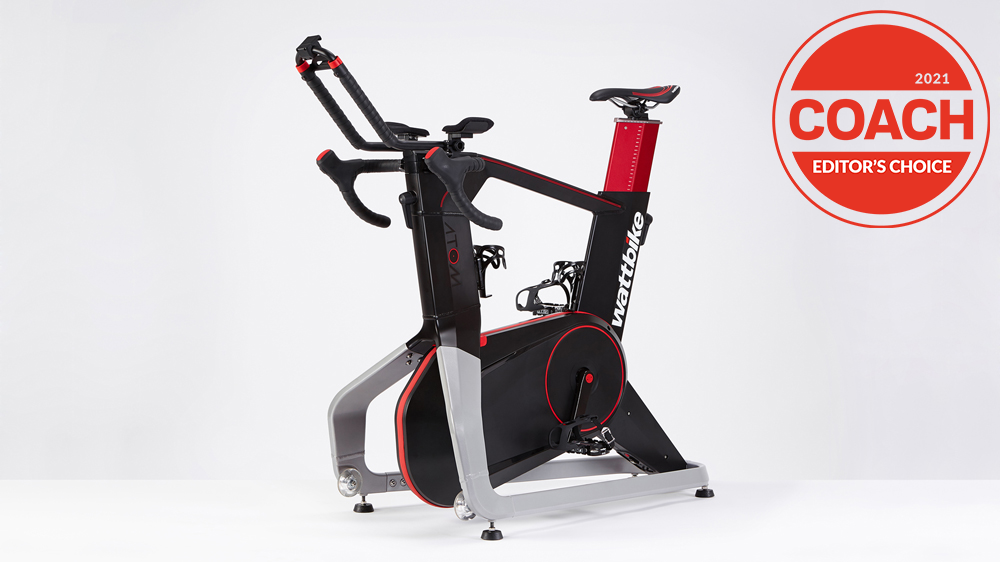Our Verdict
The Wattbike Atom is the best-value smart exercise bike for serious cyclists, offering seamless connectivity to third-party apps and access to the impressive Wattbike app, which can help you improve your technique and increase the productivity of your training.
For
- Connects easily to Zwift and other apps
- Detailed technique analysis
- Great for serious cyclists
Against
- No built-in screen
- Guided training sessions less engaging than classes
- Expensive
You can trust Coach
Some cyclists brave the elements and ride outdoors all year round, but many prefer to spend the colder months training indoors, emerging in the spring stronger than ever and ready to smash it on the open road.
There’s a range of brilliant indoor training software that caters to these cyclists, like Zwift, The Sufferfest and TrainerRoad, but to take advantage of them you need a smart trainer.
This can be either a turbo you mount your own bike on or a full exercise bike. In the case of the latter you have to pay a premium to get a top-quality machine, with prices north of £2,000 as standard. Sometimes a long way north of that price, as in the case of the excellent Wahoo KICKR Bike.
Of this type of smart exercise bike the Wattbike Atom is the value pick, despite its not inconsiderable price of £1,899. It offers brilliant connectivity, linking to apps like Zwift in seconds and, in my experience, providing a solid connection throughout your rides. Plus, Wattbike’s clever pedalling analysis helps you to refine your technique.
The Wattbike Atom was recently updated, with the latest version getting a new electromagnetic resistance system that reacts faster to gear changes, as well as gradient changes in apps like Zwift – the latter a crucial function that smart bikes need to get right.
I tested the bike using Zwift and Wattbike’s own app. The Wattbike app has a range of workouts in it and virtual recreations of famous climbs like Alpe d’Huez and Mont Ventoux to test yourself on. There are also full training plans in the app, plus functional threshold power (FTP) tests.

The bike I tested came assembled so I can’t comment on how easy the set-up is, but I can say it’s fairly heavy at 44kg and takes up quite a lot of room owing to the frame that surrounds it on each side (the footprint is 100cm x 50cm). Naturally you benefit from that frame when it comes to stability, and even on my slightly uneven garage floor the bike barely moved around at all when I was out of the saddle and pushing hard on a climb or interval.
As well as linking up to Zwift quickly, the Wattbike Atom found my Garmin watches (I tested it with both the Fenix 6 Pro and Forerunner 745) automatically as well and beamed over plenty of useful data during each session. In fact, the only thing the bike didn’t connect with that well was the gear shifter on the right of the handlebars – this dropped out a couple of times and I had to unplug the bike to reset the connection or use the Wattbike app to change gear.
Since the improvements to the resistance centre on how well the Atom reacts to things like gradient changes in Zwift, that was the first thing I tested. I used Zwift’s Sand and Sequoias route for this, since the second half of it contains frequent changes between up and downhill riding.
While the Atom was pretty fast in responding to these changes, it’s not quite as good as my normal set-up – an Elite Direto turbo – or the Wahoo KICKR Bike I tested previously. You do notice the small amount of time it takes for the bike to clock the change in gradient and change the resistance accordingly when on undulating ground.
However, it is a very small period of time, and on rides without constant ups and downs I didn’t notice the slight lag. It doesn’t quite match up to a bike that’s £1,100 more, but there’s no doubt the Atom is a brilliant exercise bike for linking up with Zwift.
Along with Zwift I kept the Wattbike app open on my rides, using the built-in tablet holder on the Atom. The app shows the info you’d expect, like the gear you’re in and the power you’re putting out (the maximum for this is a vast 2,500W; needless to say I didn’t get close to that number), as well as Wattbike’s Polar View graph, which analyses your pedalling.

This shows the force you’re putting through the pedals, where you might be losing momentum and the balance between your right and left leg. All that data is distilled into a continually-updating graph where you’re aiming for a sausage- or at least peanut-shaped readout, rather than the figure of eight I achieved. You’re also given a Pedalling Effectiveness Score (PES), with a colour-coded target to aim for while riding, which again made for a disheartening experience in my case.
The Wattbike app does an excellent job of making complex insights into your pedalling easy to understand, and if you want to improve your technique the data is there to help you do that. I found I could improve the shape on my Polar View and my PES by focusing more on the pull-up in my pedal action, for example, and if I was a more committed cyclist I could have continued to develop and improve.
When it comes to improving your cycling performance overall, however, you need more than well refined technique. You need to sweat, and the Wattbike app is full of workouts and training plans to help you do just that. These workouts are divided into sections like endurance, HIIT and speed, with personalised targets based on your FTP, so you need to make sure the app has accurate information on that front.
The workouts use the ergo mode on the Wattbike to set the resistance so you’re hitting your target wattage during the sessions, and you can adjust your target during each interval using the gear shifter buttons. There’s also a cadence target for each section.
I tried out an endurance and a HIIT workout from the app, and they are easy to follow and seemed well designed for improving the target area of your fitness. The screen isn’t the most engaging during a workout compared with the trainer-led video workouts on home spinning bikes like Peloton and Echelon, but I tended to follow the Wattbike workout with Zwift on a separate monitor to provide a little more entertainment as I cranked through the intervals.
The training plans available are long and can help you prepare for sportives, or even multi-day rides like the Haute Route events for amateur riders. Because the workouts are based on FTP, they will suit riders of all levels, and you can check in with further FTP tests along the way to see how you’re improving.
While the Wattbike Atom doesn’t match the realistic ride feel of the Wahoo KICKR Bike, it offers a brilliant smart exercise bike experience and an impressive app at a more realistic price for most home users. You can get an excellent smart set-up using a turbo like the Elite Direto for less than a smart exercise bike, and many cyclists will prefer that because they’re riding their own bike rather than a machine, while the link-up to the Wattbike app can definitely help you improve your technique, fitness and overall performance.
Buy from Wattbike | £1,899
Editor’s note: The Wattbike Atom was reviewed in 2020, then retrospectively awarded an Editor’s Choice badge in 2021 once we had ridden the majority of the competition
See related
- It's a big hit with cyclists but is Zwift a good way to get fit?
- Zap fat, generate epic leg strength and power up your fitness with Wattbike Workouts
- Take your bike indoors for a revolution in winter riding: which are the turbo trainers worth buying?
- Bring the spinning experience home with the best spin bikes to suit every budget

Nick Harris-Fry is a journalist who has been covering health and fitness since 2015. Nick is an avid runner, covering 70-110km a week, which gives him ample opportunity to test a wide range of running shoes and running gear. He is also the chief tester for fitness trackers and running watches, treadmills and exercise bikes, and workout headphones.

